Objective truth and the Amazon are both aflame
Misinformation and disinformation comingled amid uproar around the Brazilian government’s inaction
Objective truth and the Amazon are both aflame

BANNER: (Source: @luizabandeira/DFRLab)
The Amazon rainforest is burning. As often happens during a tragedy, false information started to circulate immediately following the initial reports of the massive fires ravaging the already threatened ecosystem. Pictures purportedly showing the current ongoing devastation popped up on Facebook and WhatsApp, despite actually showing fires from years ago, often on continents far away.
The scale and the scope of false information on the fires dwarfed that which spread during similar catastrophes. Disinformation, misinformation, conspiracy theories, hyperpartisan news, Twitter traffic manipulation, and misleading memes all intermingled online, overwhelming internet users’ efforts to distinguish truth from fiction. The lack of reliable data about fires and deforestation in the Amazon — much of this data is reported only at the end of the calendar year, so most analyses were based on partial results — created further room for error, speculation, and lies.
The main implications of false information spreading in this context were twofold. First, misinformation diverted attention from concrete problem-solving to a debate about the veracity of the available information. Second, as people were bombarded with high volumes of conflicting information, they found it increasingly difficult and time-consuming to differentiate between truth and falsehood. This can, in turn, make audiences more vulnerable to influence operations and manipulated narratives pushed by state and non-state actors.
The Amazon is on fire
The debate on the Amazon fires primarily concerns their severity, and in part arises from the lack of conclusive data on fire activity and deforestation in the region.
Fires in the Amazon are often intentional and man-made; the region does not experience wildfires due to the extreme humidity. Fires are also common at this time of year as a result of routine agricultural and logging practices. After cutting trees, loggers and farmers burn the organic debris to prepare the land for agriculture or cattle-breeding. These fires are usually ignited in August, during the rainforest’s dry season.
The conflicting reports about this year’s fires began circulating before there was consolidated data for the entire month of August; the lack of reliable data in part explains the confusion.
Until August 16, the U.S. National Aeronautics and Space Administration (NASA) satellites did not detect abnormal fire activity in the region. On its website, the agency stated, “an analysis of NASA satellite data indicated that total fire activity across the Amazon basin this year has been close to the average in comparison to the past 15 years.”
On August 25, NASA updated its findings, as satellites detected a peak in fire activity: “[F]ire detections in 2019 are higher across the Brazilian Amazon than in any year since 2010,” the agency wrote.
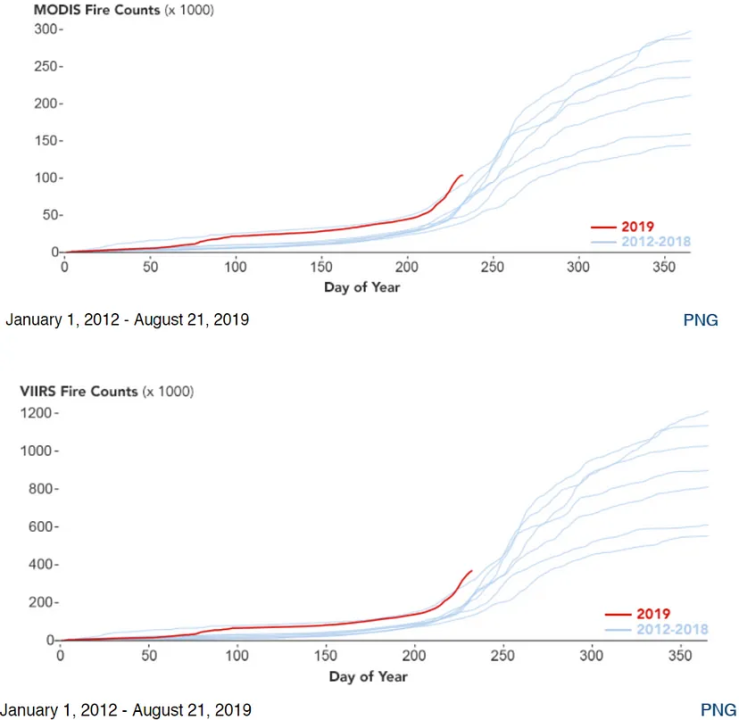
Abnormally dry years, such as those affected by the weather phenomenon El Niño, often result in a spike in the number of fires in the Amazon. The 2019 dry season, however, has not been drier than average, indicating that the increased fire activity is difficult to attribute to weather conditions alone.
Brazilian President Jair Bolsonaro has close ties to the agribusiness sector. Many of his close allies and relatives, including his son, Carlos Bolsonaro, Minister of the Environment Ricardo Salles, and Minister of Foreign Affairs Ernesto Araújo have questioned the existence of climate change. Even though blazes are more common than usual so far in 2019, the government has fined only one-third the number of people for breaking environmental laws as it did in 2018.
Deforestation also appears to be occurring at a faster rate this year, even though the data for 2019 is still partial. Brazil’s National Institute for Space Research (INPE) uses two different systems to monitor the rainforest. The first, Deter, is a less accurate system that aims to serve as a tool to notify government agents on the ground about possible new locations of deforestation. The second, Prodes, produces more accurate results on the overall pace of deforestation.
Results from Prodes, however, are only published at the end of each year, which means the results that are available now derive solely from Deter’s preliminary data. For 2019 to date, Deter shows that, in July, alerts about possible new deforestation were at their highest point since 2015.
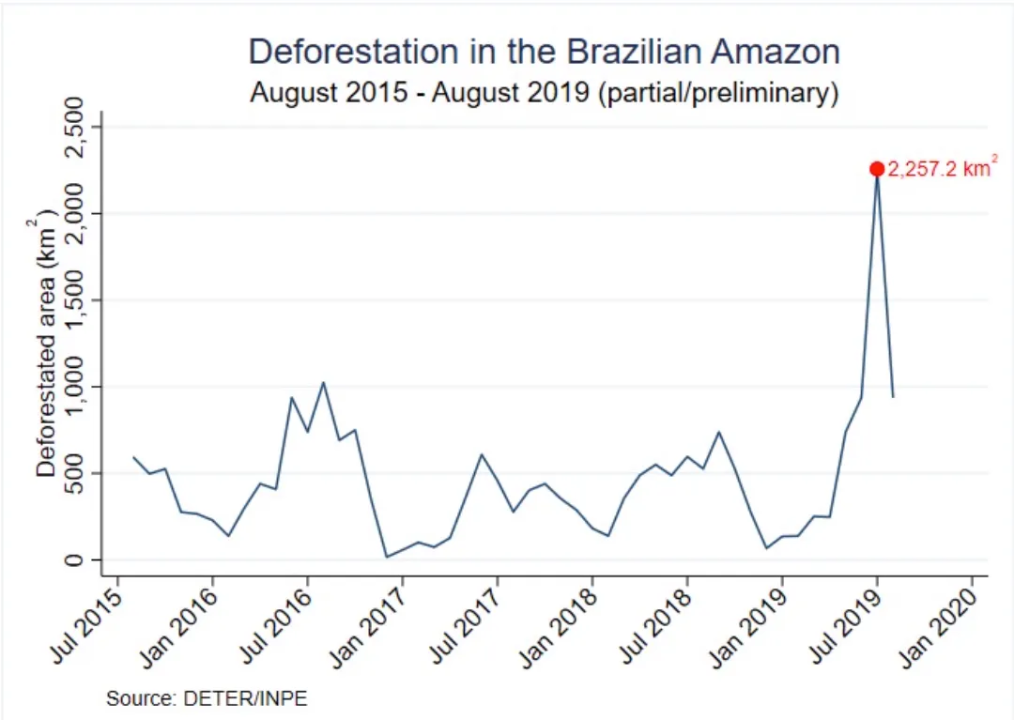
The reliability of Deter’s partial data
Specialists do not advise using Deter’s data for comparison across time, as clouds can obscure the imagery and some initial alerts of the monitoring system may in fact be false positives, when the system sends an alert without a fire being present.
Yet, on July 3, 2019, the G1 website, an initiative of the Globo Group (the largest media conglomerate in Brazil) published a claim that deforestation had increased 88 percent in the Amazon between June 2018 and June 2019.
This sparked a battle between President Bolsonaro and INPE, with the former claiming that latter’s data was not accurate and that it only served to damage Brazil’s international image.
He also made an unsubstantiated claim that the agency’s president, Ricardo Galvão, was working for various international nongovernmental organizations (NGOs). On August 3, three weeks after Bolsonaro made the claims, the Brazilian president had Galvão fired. On August 21, Bolsonaro and other government authorities blamed NGOs for the Amazon fires, claiming that they intended to draw attention to rumored funding cuts.
Bolsonaro provided no evidence for his claims. His comments echoed conspiracy theories that allege there is an international scheme underway to seize the Amazon from Brazil.
Disinformation and conspiracy theories
Bolsonaro has claimed several times that conservationist NGOs are part of a larger scheme to take the Amazon away from Brazil. The notion that there is a secret project to steal the Amazon has circulated for decades, but it gained momentum after an image of a map labeling the Amazon as an “international area” emerged online in 2000. The claim was that the map had allegedly been taken from a school textbook in the United States, which supposedly was preparing to annex the Amazon.
According to G1, investigations conducted by authorities in the United States and Brazil between the year 2000 and 2005 revealed that the piece of disinformation had been created in Brazil. The text that accompanies the map in the alleged schoolbook had grammatical errors typical of Portuguese speakers. The word “vegetable,” for instance, was written as it would be in Portuguese, “vegetal.”
This image was an early example of online disinformation, a clear and deliberate attempt to spread false information. In the early 2000s, researchers linked it to far-right military groups that believed Brazilian sovereignty over the Amazon was under threat and created the false narrative to gain popular support.
Bolsonaro, a former military captain, has referenced ideas pushed by similar groups. For example, he has cited a supposed project called “Triple A” when voicing his concerns about the alleged internationalization of the area.
The “Triple A” project started as a legitimate undertaking but became a long-lasting conspiracy theory, even after the project itself had been sidelined. Gaia Amazonas, a Colombian NGO, initially proposed “Triple A” with the goal of creating an environmentally protected corridor crossing eight countries, from the Andes through the Amazon to the Atlantic — hence the name “Triple A.” No iteration of the project included internationalizing the Amazon area or infringing on Brazil’s national sovereignty. The farthest it made it toward realization was a presentation to the Colombian government in 2015 with no further movement afterwards.
The Brazilian president, however, still claims the project is a threat to Brazil’s sovereignty over the Amazon and has been repeating the conspiracy since at least 2015, when he was in Congress. In the context of the recent fires, Bolsonaro repeated this claim on August 22, 2019.
Bolsonaro’s concerns over the impending foreign invasion of the Amazon are largely rooted in unsubstantiated conspiracy theories. There is at least one historical study, however, suggesting that authorities in the United States discussed occupying the Brazilian Amazon region in 1850. In his book The Deepest South: The United States, Brazil, and the African Slave Trade, American historian Gerald Horne says that Matthew Fointaine Maury, head of the U.S. Naval Observatory, suggested that the United States could avoid civil war by occupying the Amazon and transferring cotton production and slaves to the region.
Complicating matters further, Brazil’s government and military establishment view the Amazon differently from the international community. While members of the international community consider it ground zero for the fight against global climate change, many Brazilian officials consider the Amazon a symbol of national sovereignty and a resource to be defended from foreign exploitation.
There is emerging discussion on how to resolve the tensions inherent in these competing perspectives, but no consensus. On August 26, French President Emmanuel Macron suggested that an international status for the Amazon should be discussed, saying during an interview on the margins of the 2019 G7 Summit:
Associations, NGOs, and some international law actors have raised the question about if it is possible to define an international status for the Amazon. This is not the case of our initiative [being discussed] today, but it is a real question that appears if a sovereign state takes clear and concrete measures that oppose to the interest of the entire planet. There is a law and a political work to be done.
Misinformation spread by influencers
Besides international political figures such as French President Emmanuel Macron, who tweeted an old photo and drew some backlash for it, non-political figures such as celebrities also contributed to the messy information environment around the Amazon fires. Among those were Leonardo DiCaprio, Madonna, Gisele Bundchen, and Cristiano Ronaldo, who posted old pictures on social media in an attempt to induce action on the current problem. Since there is no indication that these people aimed to deceive the public, these examples would constitute misinformation, or the spread or false information without intent to deceive.

Images of other fires and other countries also circulated online, especially on Facebook and WhatsApp.

Hyperpartisan media
The fires also animated far-right blogs supporting Bolsonaro’s government. These blogs gained momentum during the elections in Brazil and often act as pro-government propaganda outlets.
In Brazil, blogs such as these are more influential than websites that spread completely fabricated news, such as those active throughout the 2016 U.S. election season. Although these blogs do not publish blatant lies exclusively, they promote a one-sided, hyperpartisan perspective that does not correspond to reality.
Since July, some of the most shared articles from these blogs have reinforced government views about the situation in the Amazon, in part by claiming that the media had not covered the fires with the same intensity in past presidencies and echoing the narrative that the fires were set by NGOs. Some articles also suggested that those criticizing the Brazilian government’s response to the fires were unpatriotic; they also ridiculed Macron for unwittingly posting an old photo.
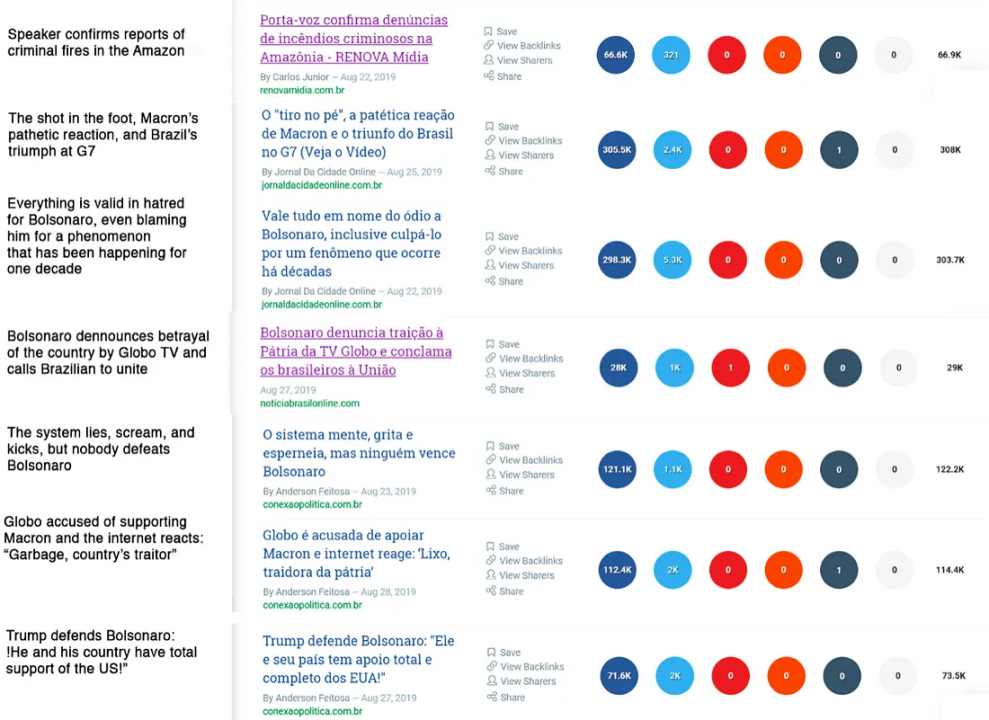
Platform manipulation and inauthentic behavior
The hashtag #PrayForAmazonas was instrumental in putting a spotlight on the fires. The hashtag is misleading, however, as Amazonas is a specific state in Brazil, but the rainforest (Amazon in English, Amazônia in Portuguese) — and fires with it — spans nine states in the north of Brazil.
The first mention of the hashtag on Twitter in August was a repost from an Instagram post. Both profiles that pioneered the hashtag were fan profiles dedicated to the singer Selena Gomez. The second mention on Twitter was a retweet of a tweet originally posted in 2016, another year in which the forest experienced brutal fires. The hashtag had previously been used sporadically on the platform for many years.

New hashtags started to appear in response to #PrayForAmazonas after it trended, including the more accurate #PrayForAmazonia. Another of the most popular was #ActForAmazonia, which implied that merely praying for the Amazon would not save it — it was time to act.
In Brazil, Bolsonaro supporters also used two other hashtags, in particular: #SomosTodosRicardoSalles (“We are all Ricardo Salles,” Brazil’s environment minister) and #AmazoniaSemONGs (“Amazon with no NGOs”).
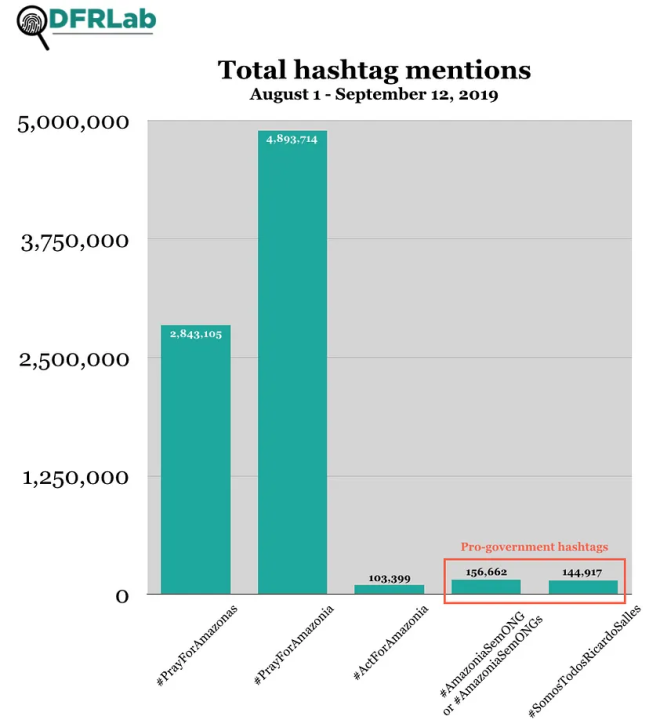
While their overall volume of use was significantly smaller than either of the #PrayFor hashtags, both pro-government hashtags exhibited more indicators of possible traffic manipulation than did the other ones. Traffic manipulation often involves a small group of people using various inauthentic tactics — sockpuppet accounts, bots, or abnormally high posting volume — to create the false impression of large grassroots support for a particular topic, narrative, or campaign.
An analysis of the first 50,ooo mentions, approximately, of each hashtag showed that the pro-government hashtags owed between 20–23 percent of their mentions to the top 1 percent most active accounts. For the other, more general hashtags, the most active accounts were responsible for around 10 percent of mentions. This finding indicated that a subset of accounts pushed the pro-government hashtags, while the others spread more organically.
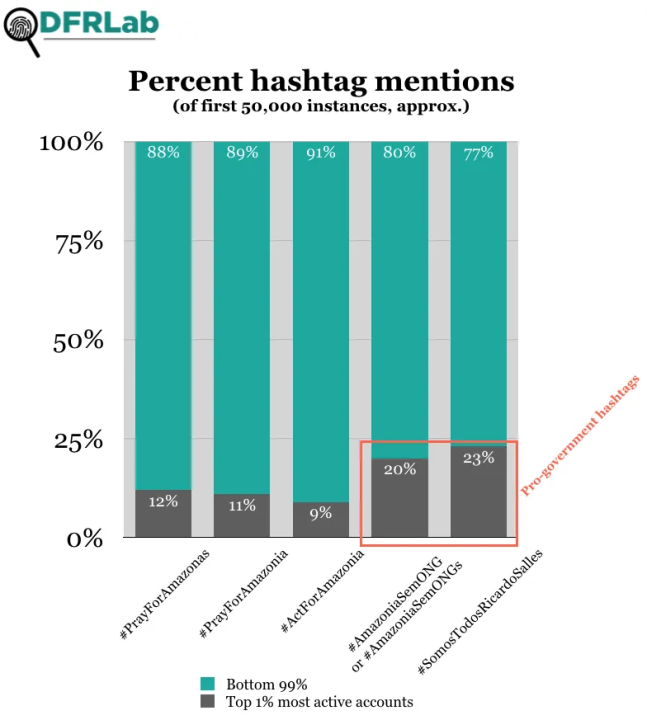
Memes
Finally, a meme played an important role in escalating the bitter feud between Bolsonaro and Macron. Memes are commonly considered a harmless form of entertainment, but they can also serve as compelling tools for pushing narratives, as they can often reduce incendiary topics into more tongue-in-cheek references and thus be more palatable for a broader audience.
As Macron escalated his criticism of the Brazilian government’s response to the Amazon fires, Bolsonaro supporters started sharing memes in an attempt to discredit the French president. One user posted an image to Bolsonaro’s Facebook page alongside a caption implying that Macron envied Bolsonaro for having a more attractive spouse.
The Brazilian president expressed approval for the post, replying “Do not humiliate the man, lol” to the Facebook post. The reply was later deleted.

Ad hominem attacks, instead of responding to an argument, are a common rhetorical device used by disinformation actors to discredit their adversaries while shifting the conversation away from the subject under discussion.
Macron reacted by saying he thought Brazilian women were likely ashamed of their president’s behavior, adding that he hoped Brazil would soon have a president that “was up to the task.” Meanwhile, a French government statement suggested that Bolsonaro had lied about Brazil’s environmental policy.
Bolsonaro demanded an apology from the French president and denied having offended Macron and his wife. When journalists reminded him of what he had said to Macron, Bolsonaro left the interview.
Conclusion
The conversation about the fires in the Amazon has displayed many of the symptoms of the contemporary struggle to differentiate false from true information. False information was spread intentionally or otherwise; conspiracy theories shaped government action; partisan groups acted on social media to push certain narratives; and a meme sparked a heated quarrel between the presidents of Brazil and France.
The overwhelming amount of false information circulating about the Amazon fires spurred people to expend extensive effort on sifting true information from falsehood; as a result, they discussed everything except the concrete steps needed to curtail the forest fires.
When citizens are exposed to false narratives without an equally robust and believable rebuttal, they can start to question the notion of objective truth, thus becoming more vulnerable to information operations.
Follow along for more in-depth analysis from our #DigitalSherlocks.


